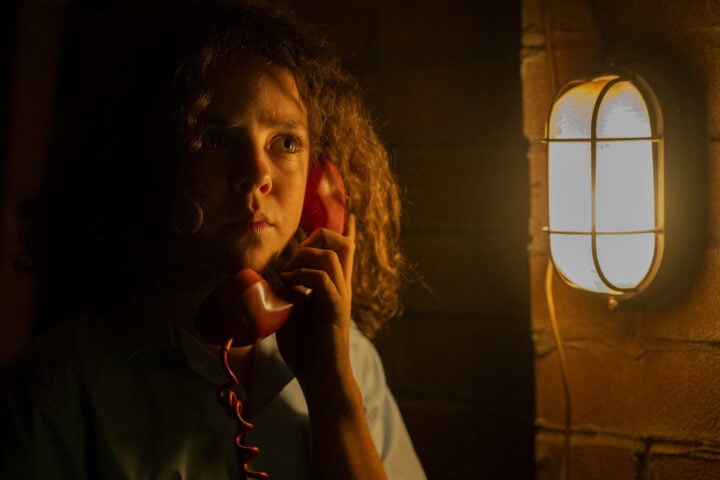In writer-director Ivan Sen’s incisive anti-detective film Limbo, Travis Hurley’s (Simon Baker) job isn’t to solve the murder of an Aboriginal girl. It’s to determine whether or not to reopen the cold case in the Australian outback mining town of Limbo—or, rather, to determine whether some other detective should even attempt to crack it.
Travis’s investigation certainly doesn’t get off to an auspicious start. After checking into a motel and shooting up, he tracks down the victim’s brother, Charlie (Rob Collins) and sister, Emma (Natasha Wanganeen). Having little reason to trust a “whitefella” cop, both refuse to speak with him. Travis is ready to pack it in when a computerized component is boosted from his car. He finds himself stuck in Limbo while he waits for the replacement part to ship.
That the investigation proceeds only because Travis is forced to wait is characteristic of the film’s purgatorial sense of time. Limbo does for the crime mystery what Rodrigo Moreno’s The Delinquents did for the heist film: Both transform their respective genre by redefining its relationship to time, though Limbo does so less in terms of runtime than narrative time. Not only does the action unfold at a measured pace, the murder in question is 20 years old—though as Charlie points out to Travis, this isn’t a long time for Limbo’s indigenous inhabitants.
Extending its concern with the aftershocks of colonialism in Australia, Limbo tackles aftermaths in a more general sense. Travis is much too late (the prime suspect, it turns out, is dead)—just as it’s too late for the town, a lightly fictionalized version of opal capital of the world Coober Pedy, where the film was shot. Many of Limbo’s remaining inhabitants, including the prime suspect’s brother, Joseph (Nicholas Hope), supplement their meager incomes by sifting through the debris for opals left behind. Colonialization has long since taken place, yet casts a long shadow. There’s no way of reversing that historical trauma, only surviving in its wake. From the outset, it’s clear that Travis won’t be solving anything. If there’s a truth of the matter, it’s buried.
Sen’s own stunning black-and-white cinematography is ideally suited to the film’s location and themes. It’s the visual equivalent of the old black Dodge that Travis rents to get around while his white sedan is out of commission. As an “outmoded” and “timeless” style of depiction, it contributes to the overriding sense that Limbo is outside of time, tossed aside by modernity. In their composition, several bird’s-eye-view shots of the mine-riddled landscape call to mind the pattern of an Aboriginal sandpainting seen in the film’s opening credits (and later on Emma’s house). But they recall, too, an early overhead shot of bootprints in the dust outside of Travis’s motel, suggesting that pattern—meaning—is ephemeral, a matter of perspective.
Additionally, the cinematography solidifies the film’s status as a noir grappling with corruption and probing moral grey areas, while at the same time echoing visually the stark divisions between white and Indigenous people in Australian society. Had Charlotte been white, the case would certainly have been left open. In this chiaroscuro light, the peculiarities of Coober Pedy—its lunar landscape of mine shafts and slag heaps, the fact that people live in “dugouts” carved in the cliff-faces to escape the pulverizing heat—take on a dreamlike quality.
Had the murder been treated as an analogy for colonialization, Limbo might have lost much of the humanism that gives it its power, but Sen manages to evoke the larger picture without setting up a one-to-one metaphor. Solving the murder, ultimately, cannot solve the tear that Charlotte’s murder has left in the fabric of a family, nor can it begin to recompense for the decades of exploitation and neglect suffered by a community.
If the attrition of time has rendered justice, if not meaningless, then beside the point, there may still be a way for Travis to reconcile Charlie and Emma, who became estranged in the aftermath of their sister’s murder, and in the process come to grips with the ghosts in his own past. Sen’s attention to how one mystery erodes over the long-term draws out the deeper, structural contestations and affinities—not unlike the forces that shape a mineral over eons—of his characters, their society, and the land on which they find themselves.
Since 2001, we've brought you uncompromising, candid takes on the world of film, music, television, video games, theater, and more. Independently owned and operated publications like Slant have been hit hard in recent years, but we’re committed to keeping our content free and accessible—meaning no paywalls or fees.
If you like what we do, please consider subscribing to our Patreon or making a donation.





Your review inspired me to watch the film. Thank you!